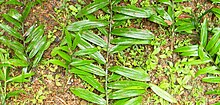| Dracaena viridiflora | |
|---|---|

| |
|
Scientific classification
| |
| Kingdom: | Plantae |
| Clade: | Tracheophytes |
| Clade: | Angiosperms |
| Clade: | Monocots |
| Order: | Asparagales |
| Family: | Asparagaceae |
| Subfamily: | Nolinoideae |
| Genus: | Dracaena |
| Species: | D. viridiflora
|
| Binomial name | |
| Dracaena viridiflora
Engl. & K.Krause
| |
Dracaena viridiflora is a shrub or small plant belonging to the family Asparagaceae.
Description
The species grows up to 5 m high. [1] Its leaves are evenly distributed along the branches. They tend to be oblong to lanceolate in outline and up to 25 cm long and 2 cm wide. [1] The surfaces of the leaves are dark green and shiny above but paler beneath; the apex is acute while sheathing commonly occurs at the base of the leaves. The inflorescence is usually terminal but less commonly axillary and up to 9 cm long [1] with flowers arranged in sessile clusters.
Distribution
The species occurs in parts of West Africa in Ghana and Nigeria then eastwards towards Cameroon and Angola. [1]
Uses
Traditionally, leaf extracts of the plant are used in the treatment of microbial infections and epilepsy. [2]
References
- ^ a b c d Bos, J.J. (1984). Dracaena in West Africa (PhD thesis). Wageningen University.
- ^ Teponno, Rémy Bertrand; Dzoyem, Jean Paul; Nono, Raymond Ngansop; Kauhl, Ulrich; Sandjo, Louis P.; Tapondjou, Léon Azefack; Bakowsky, Udo; Opatz, Till (2017-06-14). "Cytotoxicity of Secondary Metabolites from Dracaena viridiflora Engl & Krause and their Semisynthetic Analogues" (PDF). Records of Natural Products. 11 (5): 421–430. doi: 10.25135/rnp.54.17.03.050.
| Dracaena viridiflora | |
|---|---|

| |
|
Scientific classification
| |
| Kingdom: | Plantae |
| Clade: | Tracheophytes |
| Clade: | Angiosperms |
| Clade: | Monocots |
| Order: | Asparagales |
| Family: | Asparagaceae |
| Subfamily: | Nolinoideae |
| Genus: | Dracaena |
| Species: | D. viridiflora
|
| Binomial name | |
| Dracaena viridiflora
Engl. & K.Krause
| |
Dracaena viridiflora is a shrub or small plant belonging to the family Asparagaceae.
Description
The species grows up to 5 m high. [1] Its leaves are evenly distributed along the branches. They tend to be oblong to lanceolate in outline and up to 25 cm long and 2 cm wide. [1] The surfaces of the leaves are dark green and shiny above but paler beneath; the apex is acute while sheathing commonly occurs at the base of the leaves. The inflorescence is usually terminal but less commonly axillary and up to 9 cm long [1] with flowers arranged in sessile clusters.
Distribution
The species occurs in parts of West Africa in Ghana and Nigeria then eastwards towards Cameroon and Angola. [1]
Uses
Traditionally, leaf extracts of the plant are used in the treatment of microbial infections and epilepsy. [2]
References
- ^ a b c d Bos, J.J. (1984). Dracaena in West Africa (PhD thesis). Wageningen University.
- ^ Teponno, Rémy Bertrand; Dzoyem, Jean Paul; Nono, Raymond Ngansop; Kauhl, Ulrich; Sandjo, Louis P.; Tapondjou, Léon Azefack; Bakowsky, Udo; Opatz, Till (2017-06-14). "Cytotoxicity of Secondary Metabolites from Dracaena viridiflora Engl & Krause and their Semisynthetic Analogues" (PDF). Records of Natural Products. 11 (5): 421–430. doi: 10.25135/rnp.54.17.03.050.